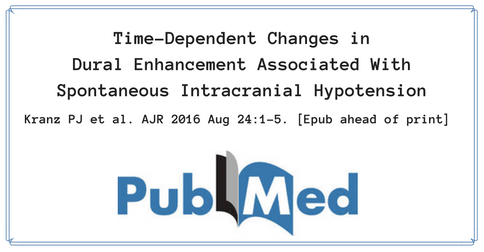This very recent publication by Peter Kranz, MD and his colleagues at Duke University in Durham, NC provides new insight into the presence or absence of dural enhancement on brain MRI in patients with spontaneous intracranial hypotension (SIH) secondary to spinal CSF leak.
It is well known by those more familiar with this disorder that the classic imaging findings seen on brain MRI (see our post on SEEPS for more info) may be absent, so the absence of these findings does not rule out intracranial hypotension. This study found that in patients with a longer duration of symptoms, the specific finding of dural enhancement, the most common finding, was more likely to be absent.
The conclusion of the authors:
Increasing symptom duration in SIH is associated with decreased prevalence of abnormal dural enhancement on brain MRI. Because dural enhancement is considered a hallmark imaging feature of this condition, its absence may exacerbate the problem of underdiagnosis in chronic cases of SIH.
Time-Dependent Changes in Dural Enhancement Associated With Spontaneous Intracranial Hypotension.
Kranz PG, Amrhein TJ, Choudhury KR, Tanpitukpongse TP, Gray L.
AJR Am J Roentgenol. 2016 Aug 24:1-5. [Epub ahead of print]
Abstract
OBJECTIVE:
The objective of our study was to determine whether the presence of individual imaging signs of spontaneous intracranial hypotension (SIH) is correlated with increasing duration of headache symptoms. Of particular interest is the relationship of symptom duration to dural enhancement because it is the most commonly identified imaging sign in patients with SIH.
MATERIALS AND METHODS:
Eighty-nine patients with SIH who underwent pretreatment brain MRI and total-spine CT myelography and whose medical record included data on the duration of clinical symptoms were included in this cross-sectional retrospective study. Brain imaging was reviewed for the presence of dural enhancement, brain sagging, and the “venous distention” sign. CT myelograms were assessed for CSF leak. If present, a leak was subcategorized as a high-flow or low-flow leak. Differences in headache duration between subjects with and those without individual imaging signs were compared.
RESULTS:
Subjects without dural enhancement on brain MRI had a longer average duration of symptoms than those with dural enhancement present (average symptom duration: 45.3 ± 59.0 [SD] vs 15.1 ± 33.0 weeks, respectively; p = 0.002). No difference in symptom duration was observed between subjects whose MRI studies showed and those whose MRI studies did not show brain sagging (p = 0.10) or the venous distention sign (p = 0.21). The presence of a CSF leak on CT myelography was not associated with symptom duration (p = 0.56) except in the subgroup of patients with low-flow leaks.
CONCLUSION:
Increasing symptom duration in SIH is associated with decreased prevalence of abnormal dural enhancement on brain MRI. Because dural enhancement is considered a hallmark imaging feature of this condition, its absence may exacerbate the problem of underdiagnosis in chronic cases of SIH.
KEYWORDS:
CSF leak; CT myelography; brain MRI; spontaneous intracranial hypotension
PMID: 27557149
DOI: 10.2214/AJR.16.1638

